#Zhenyuanopterus
Explore tagged Tumblr posts
Text
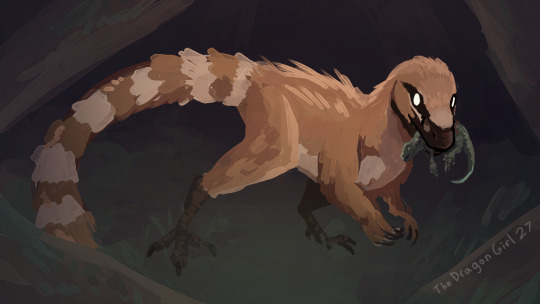
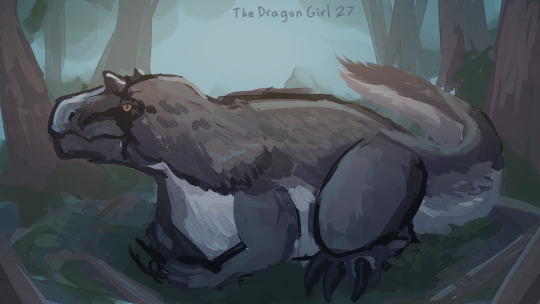

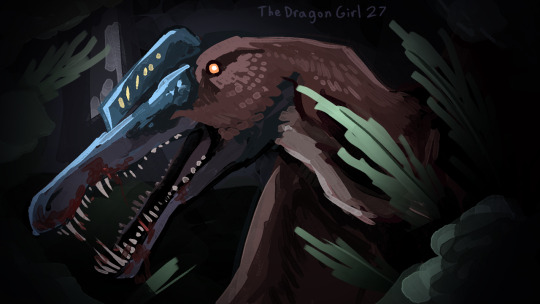
Seen a lot of paleostream art on here and decided to finally try catching one of the streams myself and drawing along with it, twas fun
these fellas are all from the Yixian Formation.
#paleoart#Psittacosaurus#Sinosauropteryx#Yutyrannus#Zhenyuanopterus#dinosaur#pterosaur#theropod#ceratopsian#Mesozoic#dragon draws creatures#kinda crazy learning the first 3 are all from the same place considering id call em pretty significant creatures for one reason or another#like scentifically significant more than like in terms of popularity i mean#also fun fact Yutyrannus is one of my all time fav dinosaurs#floofy t-rex my beloved
178 notes
·
View notes
Text







Rhamphorhynchus, Quetzelcoatlus, Microraptor, Confuciusornis, Pteranodon, Nyctosaurus, and Zhenyuanopterus!
[ID: colorful, stylized digital illustrations of the above listed dinosaurs and pterosaurs, in order. All except quetzelcoatlus are depicted in flight. End.]
I drew a bunch of ancient aerial animals this month! Microraptor is classified as a dromaeosaurid and Confuciusornis as an avialan; the rest are pterosaurs. Taxonomy is wild!
2K notes
·
View notes
Text





all the times i drew voltaje as different pterosaurs
wukongopterus, tapejara, zhenyuanopterus, anurognathus, geosternbergia
144 notes
·
View notes
Text



wash is a zhenyuanopterus. i really love pterosaur furries with fucked up strange arms. this man could be quadrupedal if he wanted to
28 notes
·
View notes
Text
My big idea for Genie Team Season 10
Well, this is my 500th post, so I thought I’d talk about something big. That being one big idea I have for Grantgfan’s Genie Team season 10.
With that being the 10th season, I thought that my idea for it would be pretty big too. And my idea for The Genie Team season 10 is… the genies, their masters, and their friends finding out the realization of dinosaurs (and other prehistoric creatures) all around the world.
And this whole thing would be teased at the end of season 9, where a large map of the world with thumbtacks stuck in it, with each one depicting a known location of dinosaur sightings. They’d be 14 in all (at the moment); with 5 in North America, 3 in South America, 4 in Africa, 1 in Indonesia, and 1 in Australia. And as season 10 progresses, more thumbtacks would be added to the map, with a different color representing a different wave; like red for wave 1, blue for wave 2, green for wave 3, and yellow for wave 4.
And speaking of waves, the dinosaurs and other prehistoric creatures would make appearances in the several waves below. WAVE 1: Dryosaurus, Gallimimus, Homalocephale, Kentrosaurus, Pachycephalosaurus, Styracosaurus, Ankylosaurus, Brachiosaurus, Camarasaurus, Corythosaurus, Edmontosaurus, Ouranosaurus, Parasaurolophus, Stegosaurus, Albertosaurus, Ceratosaurus, Dilophosaurus, Velociraptor, Acrocanthosaururs, Allosaurus, Spinosaurus, Tyrannosaurs Rex, Triceratops, Torosaurus, Carcharadontosaurus, Alioramus, Apatosaurus, Baryonyx, Compsognathus, Deinonychus, Diplodocus, Iguanodon, Maiasaura, Ornithomimus, Panoplosaurus, Tenontosaurus, Thescelosaurus, Wuerosaurus, Yangchuanosaurus, Pteranodon, Dimorphodon, Mosasaurus, and Tylosaurus.
WAVE 2: Othnielia, Hypsilophodon, Mamenchisaurus, Supersaurus, Brontosaurus, Ultrasaurus, Lambeosaurus, Shantungosaurus, Anatotitan, Olorotitan, Tsintaosaurus, Saurolophus, Hadrosaurus, Altirhinus, Centrosaurus, Einiosaurus, Pentaceratops, Euoplocephalus, Protoceratops, Psittacosaurus, Avaceratops, Microceratus, Orodrmeus, Gastonia, Edmontonia, Altirhinus, Brachylophosaurus, Gryposaurus, Hoplitosaurus, Stegoceras, Prenocephale, Tuojiangosaurus, Lexovisaurus, Paranthodon, Miragaia, Struthiomimus, Troodon, Proceratosaurus, Herrerasaurus, Torvosaurus, Tarbosaurus, Carnotaurus, Majungasaurus, Desplatosaurus, Suchomimus, Irritator, Procompsognathus, Ornitholestes, Cearadactylus, Geosternbergia, Nyctosaurus, Elasmosaurus, Plesiosaurus, and Styxosaurus.
WAVE 3: Dreadnoughtus, Alamosaurus, Argentinosaurus, Paralititan, Patagotitan, Sauroposeidon, Puertasaurus, Therizinosaurus, Convolosaurus, Leaellynasaurua, Stenopelix, Garudimimus, Wannanosaurus, Parkosaurus, Nipposaurus, Callovosaurus, Segnosaurus, Deinocheirus, Leptoceratops, Plateosaurus, Mussaurus, Melanosaurus, Oviraptor, Gigantoraptor, Caudipteryx, Lesothosaurus, Camptosaurus, Camposaurus, Yutyrannus, Rugops, Utahraptor, Dakotaraptor, Austroraptor, Sinosauropteryx, Mapusaurus, Tyrannotitan, Giganotosaurus, Gorogasaurus, Chirostenotes, Sinraptor, Microraptor, Sinornithosaurus, Archaeopteryx, Epidexipteryx, Caelestiventus, Tupuxuara, Zhenyuanopterus, Tropeognathus, Ornithocheirus, Hatzegopteryx, Alanqa, Hainosaurus, Icthyosaurus, Dakosaurus, Pliosaurus, and Temnodontasaurus.
WAVE 4: Shunosaurus, Saltasaurus, Nigersaurus, Amaragasaurus, Sinoceratops, Nasutoceratops, Agujaceratops, Chasmosaurus, Chungkingosaurus, Gigantspinosaurus, Dravidosaurus, Nodosaurus, Sauropelta, Minmi, Muttaburrasaurus, Dracorex, Stygimoloch, Dromiceimimus, Coelophysis, Eoraptor, Syntasaurus, Staurikosaurus, Saltopus, Shamosaurus, Struthiosaurus, Masiakasaurus, Eustreptospobdylus, Monolophosaurus, Limnoscelis, Labyrinthodontia, Diplocaulus, Koolosuchus, Metriorhynchus, Microposaurus, Sarcosuchus, Deinosuchus, Ichthyostega, Eogyrinus, Cacops, Seymouria, Prinoshuchus, Acanthostega, Eryops, Mastodonsaurus, Metoposaurus, Nothosaurus, Tanystropheus, Mesosaurus, Cryptoclidus, Kronosaurus, Liopleurodon, Shonisaurus, Onchopristus, Protostega, Archelon, Globidens, Ramphorhyncus, Ludodactylus, Scaphognathus, Tupandactylus, Azdarcho, Anomalocaris, Hallucigenia, Pterygotus, Ammonite, Cladoselache, Dunkleosteus, Eustenopteron, Hylonomus, Dimetrodon, Scutosaurus, Kannemeyeria, and Lystrosaurus.
That’s the four main waves of dinosaurs, pterosaurs, marine reptiles, and other prehistoric creatures that’ll appear in Genie Team season 10. It’s a lot of species, I know, but it’ll help in making season 10 of Grantgfan’s Genie Team even bigger. And I’d gladly help him in figuring out the scripts for future episodes of season 10.
2 notes
·
View notes
Photo

So it seems that I do really love drawing pterosaurs. It’s so much fun. Names of them: Harpactognathus - Cycnorhamphus - Caviramus Hamipterus - Zhenyuanopterus
#art#my art#paleoart#pterosaur#Harpactognathus#Cycnorhamphus#Caviramus#Hamipterus#Zhenyuanopterus#god i love these funky bitches
117 notes
·
View notes
Photo



recent attacks
58 notes
·
View notes
Photo

Zhenyuanopterus via Pteros
https://www.pteros.com/pterosaurs/zhenyuanopterus.html?utm_source=sendy&utm_medium=email&utm_content=newsletter&utm_campaign=zhenyuanopterus
2 notes
·
View notes
Photo



A startled zhenyuanopterus launches itself skyward upon ambush by a less than graceful juvenile graciliraptor
#my phone camera made the painting look.... disappointing#art#painting#doodles#pterosaur#dinosaur#palaeoblr#palaeotumblr
426 notes
·
View notes
Text
It’s Jehol Biota Day!
The Jehol Biota is the ecosystem of the Yixian and Jiofotang Formations of northeastern China, dating between 133 and 120 million years ago in the Early Cretaceous (from the Valanginian to Aptian ages).
It is famous because of it’s method of preservation - there were ash eruptions periodically, and the fossils are Lagerstätten, meaning that they were exceptionally well preserved with articulated skeletons, soft tissues, stomach contents, and even coloration.
This has led to an amazing understanding of various types of dinosaurs and other prehistoric animals, especially very birdy dinosaurs.
These animals lived in forests around lakes, dominated by conifers but featuring the earliest flowering plants - Archaefructus, which may have been a water plant.

By Shizhao, CC BY-SA 2.5
There were dry seasons, but it was a mostly wet formation, as many of the plants grew in very wet habitats and probably stayed close to bodies of water.
The Yixian Formation was the older of the two main Jehol Formations, and featured many, many animals. Of invertebrates, there were spiders, crustaceans, dragonflies, flies, wasps, many other insects, and molluscs, of too many to list. Fish included the lamprey Mesomyzon, ray finned fishes such as Lycoptera, Peipiaosteus, Protopsephurus, Sinamia, and Yanosteus, and a potential shark. There were frogs and toads like Callobatrachus, Liaobatrachus, and Mesophryne, as well as a salamander, Liaoxitriton.

Callobatrachus by Emily Willoughby, CC BY-SA 3.0
There were mammals, too, of course - the stem-placental Acristatherium, the stem-marsupials Akidolestes, Maotherium, Zhangheotherium, and Sinodelphys, the stem-therian (Therians being the group of Marsupials and Placentals) Eomaia, the multituberculate (a group of mammals which seem to also be stem-therians) Sinobaatar, and a significant number of Eutriconodonts, a group of early derived mammals, including Chaoyangodens, Gobiconodon, Jeholodens, Juchilestes, Meemannodon, Repenomamus, and Yanoconodon.
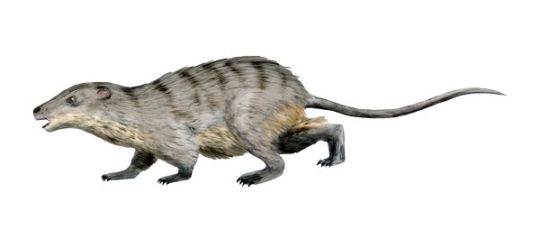
Eomaia by Nobu Tamura, CC BY-SA 3.0
There were the weird early derived Saurians (the group consisting of Lepidosauromorphs and Archosauromorphs, so Extant Reptiles), Choristoderans - Hyphalosaurus, which is known from thousands of specimens, and Monjurosuchus. Lizards included Dalinghosaurus, similar to the modern Chinese Crocodile Lizard; Liushusaurus and Yabeinosaurus, lizards relatedx to modern geckos and skinks, and Xianglong, a gliding lizard. Turtles included Manchurochelys and Ordosemys, both Cryptodirans, a group including giant tortoises, sea turtles, tortoises, snapping turtles, and others.

Hyphalosaurus by Matt Martyniuk, CC BY 3.0

Xianglong by Nobu Tamura, CC BY 3.0
The heroes of the formation were, of course, the Avemetatarsalians. There were many pterosaurs - Beipiaopterus, Boreopterus, Cathayopterus, Elanodactylus, Eosipterus, Feilongus, Gegepterus, Gladocephaloideus, Haopterus, Moganopterus, Ningchengopterus, Pterofiltrus, and Zhenyuanopterus.

Ningchengopterus by Nobu Tamura, CC BY 3.0
Ornithischians included the ornithopods Bolong, Jeholosaurus, and Jinzhousaurus, the ankylosaur Liaoningosaurus, and the ceratopsians Liaoceratops and Psittacosaurus. There were sauropods too - the titanosauriform Dongbeititan, a potential titanosaur, and an animal that has for now been referred to Euhelopus. But the real heavyweights were the theropods.

Jeholosaurus by @ryuukibart
There were the tyrannosauroids Yutyrannus - one of the best known tyrannosauroids with feathers - and Dilong; the compsognathus Huaxiagnathus, Sinocalliopteryx, and Sinosauropteryx - the first non-avian dinosaur known to have feathers, and also with known coloration; early Ornithomimosaurs such as Hexing and Shenzhousaurus; the early derived maniraptoran Yixianosaurus; Beipiaosaurus, a therizinosaur; and tons of Chickenparrots, such as Similicaudipteryx, Protarchaeopteryx, Ningyuansaurus, Incisivosaurus, and Caudipteryx.
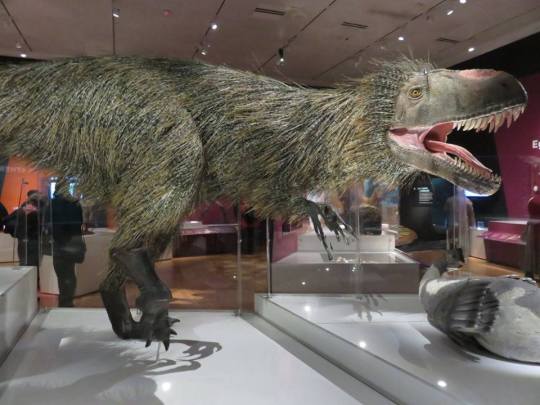
Yutyrannus, model from “Dinosaurs Among Us”, photo by me
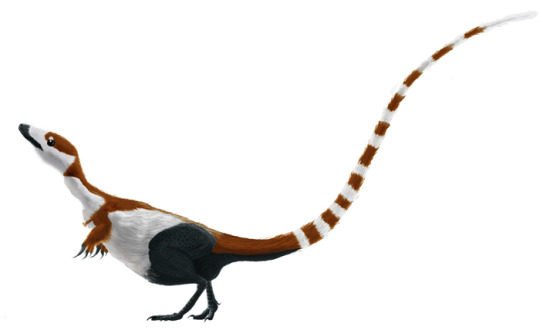
Sinosauropteryx by Matt Martyniuk, CC BY-SA 3.0
There were many Dromaeosaurids (raptors), such as Graciliraptor, Tianyuraptor, Zhenyuanlong - a raptor known from nearly complete feather traces, including extremely large wings - and Sinornithosaurus, the first Dromaeosaurid found with feathers. There were also lots of Troodontids, such as Sinusonasus, Sinovenator, and Mei, as well as unnamed members of both groups. There were early-derived Avialans such as Zhongornis, Jixiangornis, Confuciusornis, and Changchengornis. There were loads of Enantiornithines, such as Bohaiornis, Eoenantironis, Dalingheornis, Liaoningornis, Longirostravis, and Shanweiniao - an Enantiornithine that had a tail fan like modern birds. There were also Euornithines - the group which contains modern birds - such as Longicrusavis, Hongshanornis, and Archaeorhynchus. In short, this was an extremely birdy formation indeed.

Zhenyuanlong by Emily Willoughby, CC BY-SA 4.0
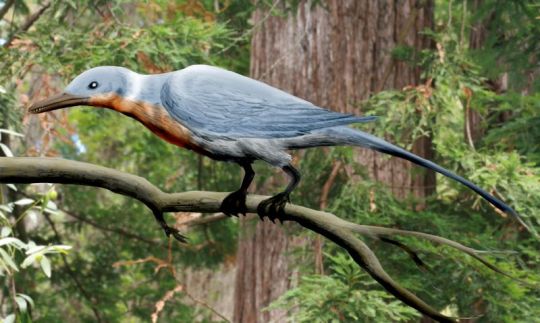
Shanweiniao by Nobu Tamura, CC BY 3.0
The Jiuofotang Formation was slightly younger, but was similar to the Yixian in terms of the animals there. There were ray finned fishes such as Jinanichthys, Lycoptera, Peipiaosteus, Protsephurus, and Sinamia. There was the mammal Liaoconodon, a Eutriconodont, as well as an unnamed mammal similar to Eomaia from the Yixian Formation. There were also Choristoderans like Philydrosaurus, Ikechosaurus, and Liaoxisaurus.

Liaoconodon by Dylan Bajda, CC BY-SA 4.0
There were many, many, many pterosaurs. This included Chaoyangopterus, Eoazhdarcho, Guidraco, Ikrandraco, Jidapterus, Liaoningopterus, Liaoxipterus, Linlongopterus, Nemicolopterus, Nurhachius, Shenzhoupterus, and Sinopterus. And, as we shall see, there were a lot of flying theropods as well, indicating that the two groups did live alongside one another just fine, and the common narrative of “birds replaced pterosaurs” has little foundation in the fossil record.
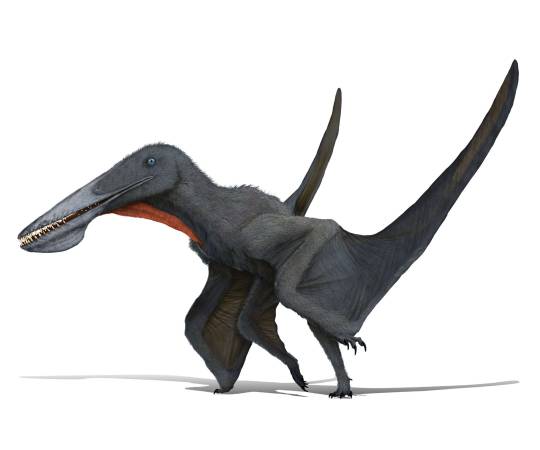
Ikrandraco, by Fabrizio De Rossi, from www.pteros.com

Chaoyangopterus, by Joschua Knüppe, from www.pteros.com
There were only a few Ornithischians - namely Chuanqilong, an ankylosaur, and Psittacosaurus, a ceratopsian. There is also an unnamed titanosaur from the formation. As for theropods, there were a lot. The tyrannosauroid Sinotyrannus was the largest predator there, there was the Chickenparrot Similicaudipteryx, and of course one of the most famous raptors, Microraptor, which was a four-winged Dromaeosaurid that we know had iridescent black feathers.
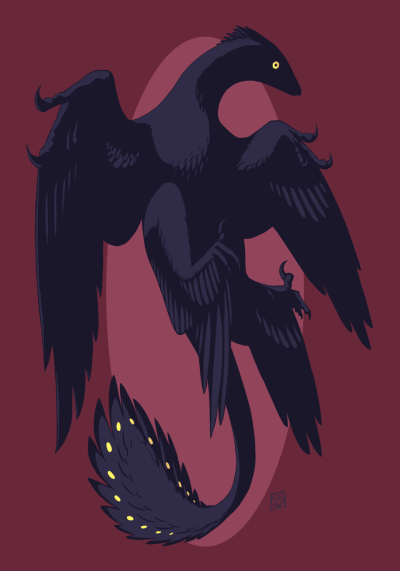
Microraptor by @artisticthingem
There were many early derived Avialans, such as Confuciusornis, Dalianraptor, Omnivoropteryx, Sapeornis, Shenshiornis, Zhongjianornis, and my personal favorite, Jeholornis, a theropod we know was a seed-eater, which is actually quite hard to determine from fossils. There were many Enantiornithines, such as Alethoalaornis, Boluochia, Cathayornis, Cuspirostrisornis, Dapingfangornis, Eocathayornis, Gracilornis, Huoshanornis, Largirostrornis, Longchengornis, Longipteryx, Rapaxavis, Xiangornis, and one of my favorites, Sinornis, which is thought to have perched. As for Euornithines, there was Chaoyangia, Jianchangornis, Parahongshanornis, Schizooura, Songlingornis, Yanornis, and Yixianornis.

Jeholornis by Matt Martyniuk, CC BY-SA 3.0
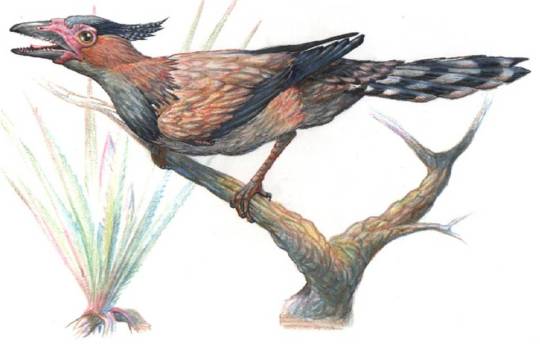
Sinornis, by Pavel Rhia, CC BY-SA 3.0
It’s plain to see why the Jehol Biota is so fascinating. At least for me, I love it because it’s clearly one of the best pictures we have of Pennaraptoran evolution - the amount of birdie dinosaurs is absolutely ridiculous. But there’s really something for everyone here - there are titanosaur-like things, some of the earliest Ceratopsians, tons of Pterosaurs, weird Choristoderans, and even some insights into the evolution of early mammals and different types of amphibians and fish, as well as the first flowering plants. The Jehol Biota is one of the best ecosystems we know about, and it definitely deserves celebration!
Sources:
https://en.wikipedia.org/wiki/Jehol_Biota
https://en.wikipedia.org/wiki/Jiufotang_Formation
https://en.wikipedia.org/wiki/Yixian_Formation
#dinosaurs#birds#pterosaurs#jehol biota#palaeoblr#prehistoric life#yixian formation#jiufotang formation
123 notes
·
View notes
Photo

I can't help it, I'm in a pterosaur phase. Blame Drawdinovember *DISCLAIMER: I am not a paleo artist nor am I trying or claiming to be. So the exploration of sexual dimorphism, displays, crests, wattles, patterns, etc etc are purely speculatory.
#pterosaur#dinosaurs#drawdinovember#paleoart#zhenyuanopterus#dragons#jurrasic park#jurrasic world#prehistoric animals#tumblr illustration#speculative biology
317 notes
·
View notes
Photo

Zhenyuanopterus skeletal by Ville Sinkkonen
#paleontology#cretaceous#pterosaur#pterodactyl#zhenyuanopterus#skeletal#boreopterid#ornithocheiroid#pterodactyloid
53 notes
·
View notes
Photo

Pterosaur of the Day: Zhenyuanopterus by Eurwentala
Zhenyuanopterus Family: Boreopteridae Time: Cretaceous Location: China Size (wingspan): 4m Note: Not a dinosaur
30 notes
·
View notes
Text
the list
bluez
church: geckolepis megalepis (director: green iguana, blue morph)
tucker: guanlong
caboose: zuul
washington: zhenyuanopterus
kaikaina: common raccoon
tex: asian water monitor, black dragon morph (allison: black saddlebags)
redz
sarge: "razorback"/feral hog
simmons: least weasel
grif: south american coati
donut: grey wolf
lopez: black rhinoceros (stole this one from reconnoiterish.)
carolina: azure damselfly
and doc is a duck-billed platypus.
#save#REPTILES. VS. MAMMALS#subject to change.#reasoning with church is that i wanted to make him a lizard that can drop its tail/scales when in distress#and all the fragments are other lizards#hence why tex is a monitor while allison is a Buge#furry rvb
4 notes
·
View notes
Photo

Anonymous request: a Zhenyuanopterus.
I told myself I was going to post something tonight, so here it is.
Dunno why I stuck with so few colors, who knows.
76 notes
·
View notes
Photo

The Crested Head of a Platanista-Mimic Pterosaur by ~Smnt2000:
Long time since the last drawing. A month, more or less. So, with the freshly delivered Tria Markers, I decided to draw one of my favourite pterosaur: Zhenyuanopterus. I love everything that is weird. And Boreopterids are certainly freaks. With their long snouts, full of needle-like teeth, their huge wings, almost-useless feet, impossible crests and little eyes, they're just irresistible. Poor fellows, and they're so neglected. Well, Chaoyangopterids are even more obscure, but still...It's a shame. They're very interesting. Boreopterids (Zhenyuanopterus in particular) resemble a cross between a pelican and a platanista dolphin, an almost blind river cetacean. I love to call them river dolphins-imitating pterosaurs, because their mouths are so similar that they must share a very similar diet and hunting method. Also, although not blind, boreopterids probablu didn't have a very good eyesight, just like platanistas.I could talk of them for hours, but this isn't the right place. Abou the restoration: the bony crest probably supported a developed structure, not dissimilar to other pterosaurs. I tried to avoid Matt Martyniuk's shape, but without realizing I almost drew the same thing. Oh well. Also, I had this almost Schoutenish desire to paint a relaxing background and I decided to unload this feeling. I admit it: it's not very realistic. But I like it. A lot. And that's all folks. Coloured with: Tria Markers, pencils. Based on: swan, Malacorhynchus duck. References: Ville Sinkkonen, Peter Schouten. Enjoy it!
20 notes
·
View notes